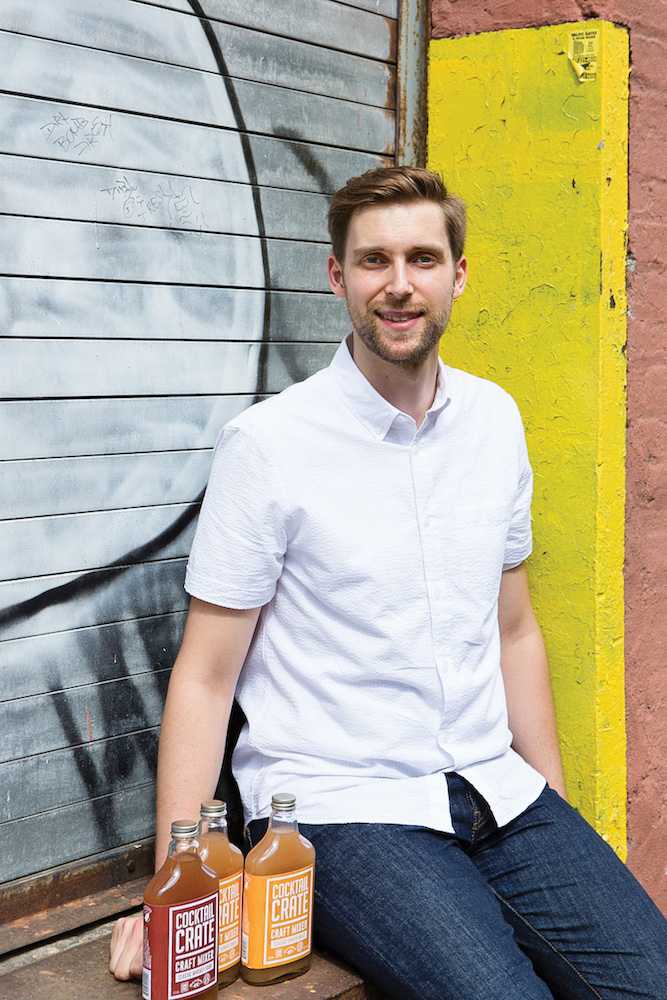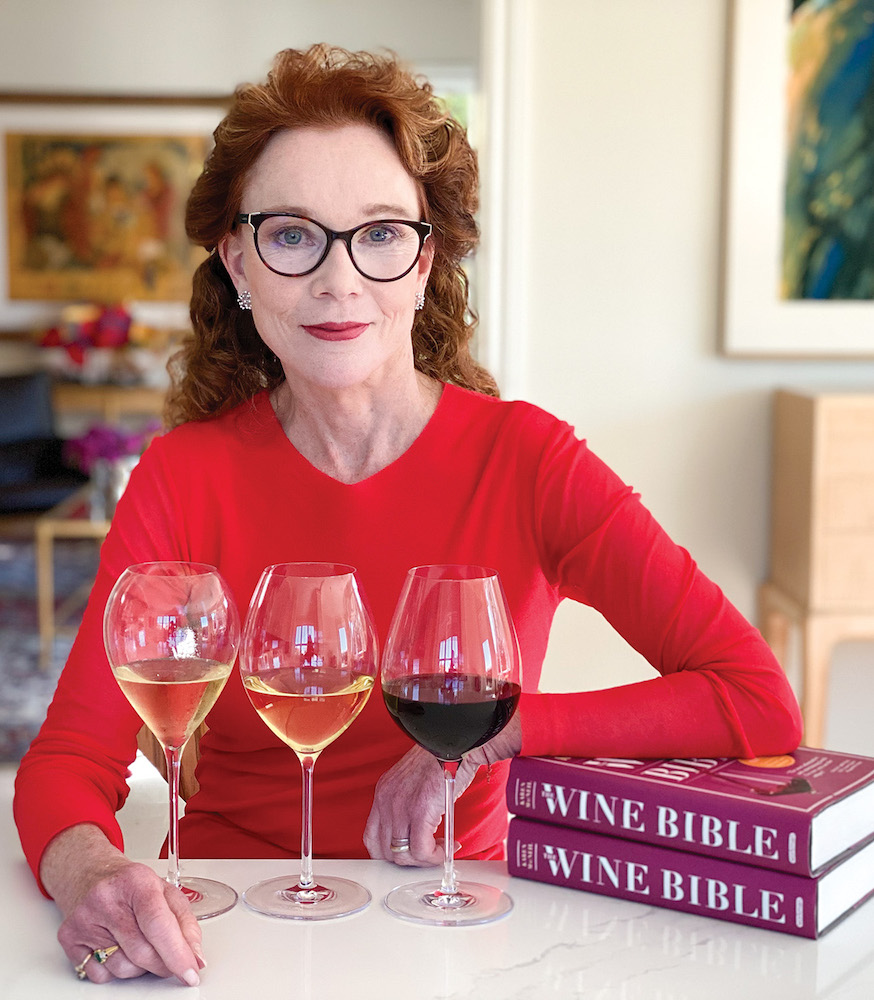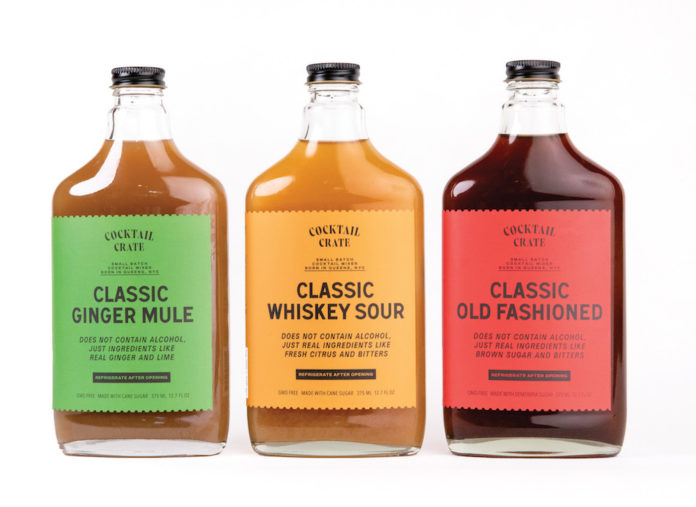Complementary products — nonalcoholic items like mixers, glassware and cannabis drinks — do not comprise a large portion of a beverage alcohol store’s SKUs. Yet they remain a reliable source of revenue.
Category trends this year naturally reflect current consumer tastes. These were affected greatly by the Covid-19 pandemic. So what should you expect in 2021? Look for more cocktail-making at home, as people became comfortable with mixology during last year’s lockdowns.
“It has given a huge boost to the category across the board,” says Alex Abbot Boyd, founder of the premium mixer brand Cocktail Crate. “The mixer category as a whole has grown about 30% over the last year.”
Cocktail Ingredients
The at-home mixology movement continues strong into 2021. Consumers now expect bar-quality cocktails in the comfort of their own homes.

“When Cocktail Crate launched back in 2013, using premium, all-natural ingredients was a real differentiator for us,” says Boyd. “Now, after eight years of growth for natural mixers and decline for conventional mixers, I believe premium ingredients are just table stakes. Now it’s about how well and how creatively you use those premium ingredients to help people make great cocktails at home.”
“I think the keys to standing out in this environment are taste and convenience,” he adds. “Can a mixer quickly make a delicious not-too-sweet cocktail? That’s what consumers want right now.”
Agreeing with him is April Wachtel, founder of Cheeky Cocktails. Her company bottles an array of premium, all-natural syrups and juices. The labels are stripped down and the liquid inside is the real deal.
“All audiences get it: our simplicity,” Wachtel explains. “Why overcomplicate it? Why not just offer whatever you would find on the back bar of your favorite cocktail bar? Your average consumer doesn’t need a huge education about what’s in ginger syrup.”
But your average consumer does need help in making mixology-quality drinks.
“It’s an empowering experience, making that level of cocktails,” Wachtel says. “We want to help people share their cocktails with friends and family in a way that doesn’t feel intimidating.”
The category sure has come a long way since the days of bottom-shelf bottles choked with artificial ingredients. For instance: Zing Zang, known for its Bloody Mary products. Their premium offerings also include Maragrita, Piña Colada and Sweet and Sour mixers.
“In 2020, for the first time, people in this category began to trade up,” says CEO Brent Albertson. “It’s hard to get all-natural ingredients, and it’s more expensive on our end. But these days, consumers demand it. We find that consumers definitely want cleaner labels and better ingredients. People have become savvier about reading and understanding labels.”
Along with the all-natural movement, Albertson also sees consumers growing accustomed to bar-quality flavors in their own mixology. “It’s a balance with consumers,” he says. “They want products to be cleaner but also have big, bold flavors.”
Interestingly, this trend runs parallel with the rise of low-ABV, less-alcohol products.
“We believe that people do still want full-strength, bold drinks, even as everyone jumps into hard seltzers,” Albertson says.
Consumers are also eager for additional education.
“As a company, we launched virtual cocktail classes and taught over 15,000 people last year how to make cocktails at home,” says Tory Pratt, founder of Pratt Standard Cocktail Co. The company makes premium cocktail syrups inspired by pre-Prohibition recipes, including a recently launched Old Fashioned syrup.
“There’s huge demand and curiosity about craft cocktailing at home,” Pratt adds. “Consumers in the U.S. had an extra $20 billion last year to spend on stocking home bars, as they did not go out to bars and restaurants. In March and April of last year, when lockdowns were beginning, we saw sales on our website increase substantially.”
Pratt does not see the at-home cocktail movement ending anytime soon, as people realize that their homes are well suited for mixology.
“In many ways the home bar is better equipped than most bars you could go out to,” Pratt says. “Your ice is coming directly from the freezer, as opposed to from an ice well (which can result in over-dilution), and you have a blast glassware chiller — your freezer. In many cases, home bartenders just need a little education as to how to get started and then they can make almost any cocktail for themselves.”
So what’s next for this category?
“We are seeing huge growth in garnishes for premium cocktails, like Traverse City Whiskey Co.’s premium cocktail cherries,” says Boyd. “If a customer is making an Old Fashioned at home with our Old Fashioned mix, it makes sense that they will soon want to have a great cherry to accompany it.”

Hardware and Glassware
As the pandemic kept consumers home, people indulged with high-end glassware and hardware.
Perhaps the best example of the latter is Coravin. This company launched in 2013 with its Wine Preservation Opener. Using needles and argon gas, the technology penetrates through corks and draws out wine in a way that keeps bottles fresh for significantly longer that simply popping the cork.
The company has continued to innovate. Coravin’s newest products aim for more affordable price points. “The wine trade can be elitist, but 90% of all wine consumed in the U.S. off-premise is under $20,” says CEO Christopher Ladd. “We’re trying to have more options for that subset of consumer. We have our Model 3 Wine Preservation Opener down to $149, from $199.”
Coravin also recently launched its $99 Pivot. “Pull the cork and put in this stopper and you can drink the wine like it was fresh for up to four weeks,” says Ladd. “We think this is a great value. We’re trying to bring more products to more people.”
This includes a champagne and sparkler product slated to hit markets this summer. Ladd says this new innovation provides almost a month’s preservation for bubbly wines.
Altogether, these products tap into the broad trend of “healthier” alcohol consumption — including drinking less but better. Ladd also believes that Coravin is well positioned as more Millenials discover wine.

“We’re betting with Pivot that younger consumers will continue to enter the wine industry, and find their preferences,” he says. “The Millennial group is an experiential audience. Once they’ve seen the breadth and depth of wine, they’ll love it.”
Similar thinking defines Flavor First, a line of wine glasses designed around specific profiles. The line includes Crisp & Fresh (fresh, bright wines), Creamy & Silky (round, silky texture) Bold & Powerful (bold texture and firm structural backbone) and Petite Stem (with a foot to allow for swirling and easier handling).
“This line meets the consumer demand for upscale glassware because it is thin at the lip, similar to other fine crystal glasses, yet has the sturdy and pragmatic quality of being dishwasher safe, and has a broad base for swirling and is economical, in case one breaks it,” explains Founder Karen MacNeil. “Our Flavor First glasses also fit the current trend of casual at-home drinking, because of their style, utility and durability.
Kyle Swartz is editor of Beverage Dynamics magazine. Reach him at kswartz@epgmediallc.com or on Twitter @kswartzz. Read his recent piece 10 American Whiskey Trends in 2021.




